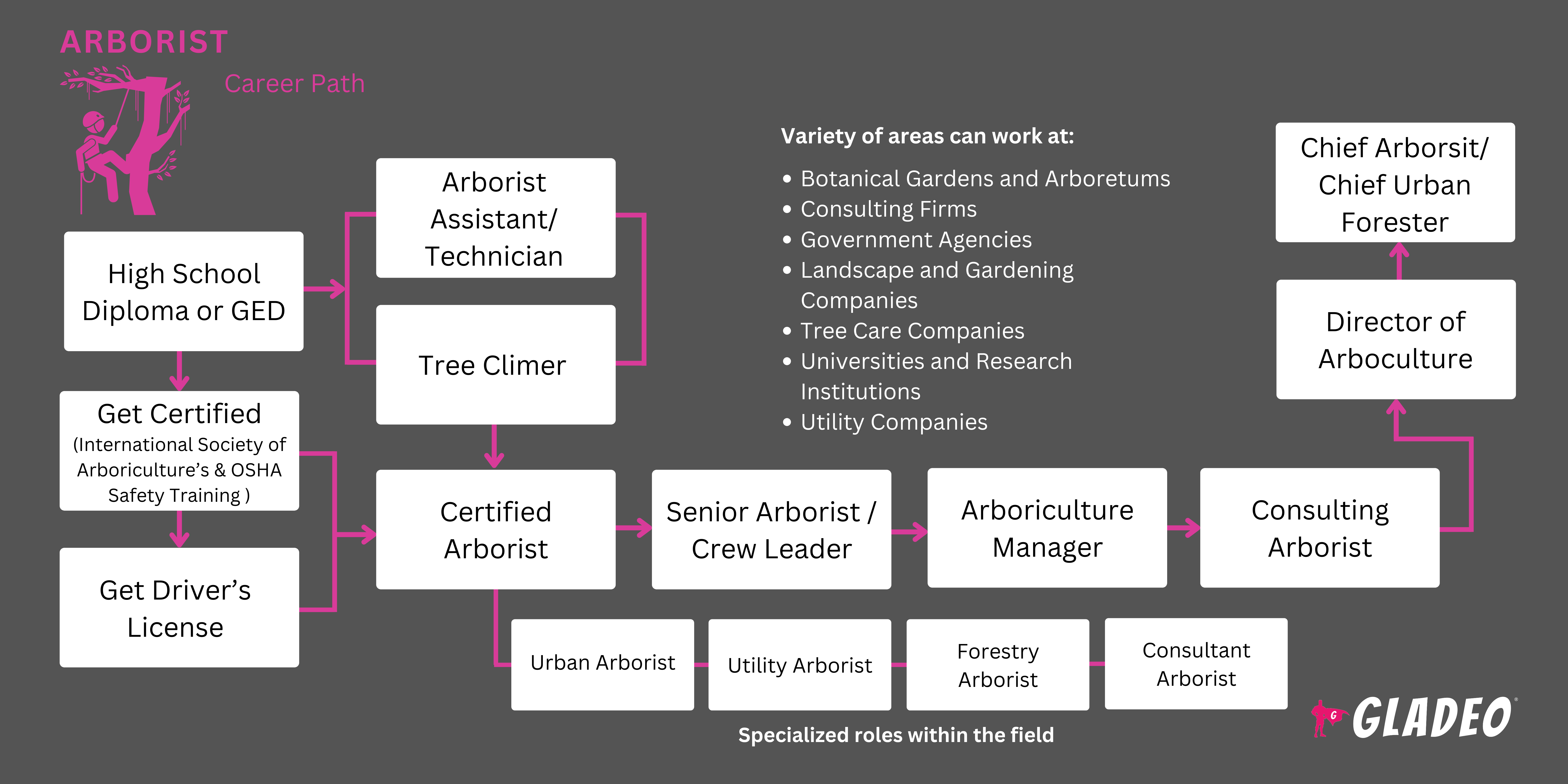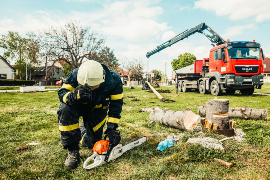Spotlights
Người trồng cây, Người leo núi, Công nhân mặt đất, Người làm đất, Người lao động, Kỹ thuật viên chăm sóc sức khỏe thực vật, Người leo cây, Tông đơ cây, Tông đơ, Người cắt tỉa
Our world is covered in trees, which are crucial for life on Earth. Trees provide shade, cool and purify the air, and reduce pollution by absorbing carbon dioxide and producing oxygen. They support wildlife habitats and their roots hold the soil together, preventing erosion and floods while boosting agriculture productivity.
In addition, many are filled with compounds used in medicines and, of course, they’re essential for the wood we use to build homes and furniture! But tree populations face unprecedented challenges as the world’s population rises, the climate changes, and growing industrial pollution takes its toll.
That’s why Arborists are more important than ever! Arborists take care of trees and provide maintenance to enhance their health and appearance. Like “tree surgeons,” they identify and treat diseased trees, apply soil amendments and pesticides, carefully trim or prune branches too close to structures and power lines, and clear away fallen trees. They’re also skilled climbers who use ropes and harnesses to reach the highest branches within the tree canopy.
- Helping trees stay healthy, pest-free, and beautiful
- Làm việc ngoài trời và duy trì hoạt động thể chất
- Giữ an toàn cho cư dân cộng đồng và tài sản khỏi cây đổ và chân tay
- Nâng cao giá trị tài sản
Lịch làm việc
- Most Arborists work full-time, with some part-time opportunities. Schedules may shift seasonally, with additional hours needed in spring and summer. Arborists often travel locally within a specific area to provide services.
Nhiệm vụ tiêu biểu
- Review tasks and prepare equipment and vehicles for tree care operations.
- Discuss job specifics, costs, and scheduling with clients.
- Inspect sites for hazards. Set up signs to warn pedestrians, vehicles, etc.
- Diagnose tree health issues, including diseases, pests, and damage.
- Use climbing gear or bucket trucks to access high branches safely.
- Hoist tools up to climbers.
- Use saws, shears, and pole pruners to trim branches and shape trees.
- Trim or prune branches near structures or power lines to reduce safety risks.
- Prune broken or diseased tree limbs.
- Secure cut branches with ropes to safely lower down.
- Apply protective treatments to exposed areas on trees.
- Process branches and debris through shredders or chippers.
- Clear worksites of debris using trucks for transport and disposal.
- Apply soil amendments, water, and nutrients to promote tree health.
- Perform root injections to strengthen trees and enrich soil.
- Mix and apply pesticides to control pests and prevent damage.
Trách nhiệm bổ sung
- Use cables, braces, and stakes to stabilize trees.
- Transplant small trees and shrubs carefully to protect roots.
- Grind or remove stumps, as needed for landscaping purposes.
- Remove decayed wood from tree cavities and seal openings.
- Operate and maintain equipment like boom trucks, stump grinders, and chippers.
- Inspect, clean, and maintain tools, performing minor repairs as needed.
- Wear appropriate personal protective equipment and follow safety guidelines.
- Train new hires on safety protocols and arboricultural techniques.
- Keep work areas safe by monitoring for potential hazards.
Kỹ năng mềm
- Chú ý đến chi tiết
- Clear communications
- Quyết định
- Tập trung
- Goal orientation
- Phối hợp tay-mắt
- Sáng kiến
- Phương pháp
- Tinh ý
- Tổ chức
- Kiên nhẫn
- Tập trung vào an toàn
- Phán xét hợp lý
- Quản lý thời gian
Kỹ năng kỹ thuật
- Ability to lift and carry up to 70 lbs
- Physical endurance and stamina
- Operation and maintenance of arboricultural vehicles (such as boom trucks), equipment (such as loaders and chippers), and tools (such as chainsaws, pruners, and other tree-trimming tools)
- Sơ cứu và hô hấp nhân tạo
- Soil properties and tree nutrients
- Tree support systems (braces, cables, stakes)
- Personal protective equipment (helmets, gloves, hearing protection, etc.)
- Botanical gardens and arboretums
- Government agencies (federal, state, local)
- Công ty cảnh quan và chăm sóc cỏ
Arborists are expected to maintain a high level of physical fitness and stamina since the work demands strength, endurance, and agility. The physical strain of climbing trees, handling heavy equipment, and working long hours outdoors can lead to sore muscles and potential repetitive strain injuries.
Arborist work can be dangerous due to risks of falling or slipping, cuts from sharp tools and chainsaws, and dropping tree branches and limbs. There’s also exposure to inclement weather, noise, pests, and chemicals.
Additionally, Arborists must stay adaptable because weather conditions and job plans can change in a hurry. For example, if the wind picks up and they’re working at an elevated height, they may have to come down and postpone the rest of the day’s work. Another challenge is the potential for unpredictable hours, such as during an emergency storm damage cleanup!
The arboriculture field is experiencing significant advancements in technology and a shift toward environmental sustainability!
Many Arborists now use advanced software tools for tree mapping, allowing them to digitally monitor tree health and track growth patterns over time.
GPS and GIS systems are frequently employed to map and manage tree locations, enhancing the precision and efficiency of tree care.
Additionally, tree care companies are leveraging data analytics to predict pest infestations and proactively address potential issues, helping them resolve problems before they escalate.
Environmentally conscious practices are also becoming mainstream in arboriculture. Many Arborists are adopting biodegradable oils for chainsaws and exploring electric-powered equipment to reduce their carbon footprint.
There is also a growing shift towards organic pest control methods and soil health management techniques, which promote biodiversity and minimize the need for synthetic chemicals. These eco-friendly approaches reflect an industry-wide commitment to sustainable practices that benefit both tree health and the broader ecosystem.
Arborists are typically physically active people who like working outdoors with their hands. They’re comfortable with hand tools and powered equipment and might have taken shop classes in high school.
They may have grown up in rural areas, perhaps taking jobs helping out on farms. Strong verbal communication skills and teamwork are also essential, and these may have been developed from extracurricular activities like playing sports.
- Arborists need a high school diploma or GED. A college degree isn’t needed, but many workers hold a certification, such as the International Society of Arboriculture’s Certified Arborist, Certified Arborist Utility Specialist, or others.
- Các chủ đề khóa học phổ biến bao gồm:
- Abiotic and Biotic Disorders
- Rigging and Climbing
- Soils and Fertilization
- General Diagnosis
- Pest Management
- Plant Health Basics
- Planting
- Principles of Pruning
- Tree Physiology
- Tree Support Systems
- Urban Forestry
- Having a driver’s license or commercial driver's license (CDL) may help boost your application.
- In addition, Arborists must be able to lift and carry up to 70 lbs, and have the physical endurance and stamina to climb trees with proper equipment.
- They must also learn how to operate and maintain vehicles such as boom trucks; equipment such as loaders and chippers; and hand and power tools such as chainsaws, pruners, etc.
- Entry-level workers can learn safety protocols and duties through On-the-Job training and OSHA safety training. First aid and CPR courses may also be required.
- Due to the risks associated with this profession, employers may require regular drug testing.
- Arborists don’t need a college degree, but some complete arboriculture classes or certifications from a local vocational school, community college, or online program.
The International Society of Arboriculture offers several certifications, such as:
- Vườn ươm được chứng nhận ISA
- Chuyên gia tiện ích vườn ươm được chứng nhận ISA
- Chuyên gia thành phố Arborist được chứng nhận ISA
- Chuyên gia leo cây được chứng nhận ISA
- Chuyên gia nâng trên không công nhân cây được chứng nhận ISA
- ISA Tree Risk Assessment Qualification
ISA also offers several online courses, including:
- Intro to Arboriculture Abiotic Disorders
- Intro to Arboriculture Biotic Disorders
- Intro to Arboriculture Fertilization
- Intro to Arboriculture General Diagnosis
- Intro to Arboriculture Identification Principles
- Intro to Arboriculture Selection
- Intro to Arboriculture Tree Anatomy
- Urban Forestry
Other learning paths include:
- Tree Care Industry Association - Certified Treecare Safety Professional
- American Society of Consulting Arborists - Registered Consulting Arborist
- Utility Arborist Association - Utility Arborist Certification Program
- ANSI A300 Tree Care Standards and Publications
- Future Arborists should participate in sports and physical fitness activities to get in shape.
- Take shop classes where you can learn about safe tool and equipment usage.
- Volunteer or apply for outdoor jobs working with landscaping and tree care. Learn about common tree diseases and pests and ways to identify and treat them.
- Look for companies offering arborist internships.
- Get your driver’s license and consider applying for a CDL.
- Talk to a working Arborist to ask about the job’s pros and cons.
- Keep a list of potential personal references. Ask their permission to share their contact info with employers.
- Watch videos (such as on Strider Trees YouTube channel) to learn about safe climbing and groundsman work.

- Smaller local companies may list job openings on Craigslist while larger companies might post on Indeed or Angi. State and federal employers also use USAJOBS.
- Search online for local tree service providers and check out their websites. Even if you don’t see a job vacancy, reach out to inquire about upcoming opportunities or seasonal work.
- Review Arborist resume templates for ideas. Be sure to work in relevant keywords in your resume, such as:
- Chainsaw Operation
- Climbing Techniques
- Equipment Maintenance
- Fertilization Techniques
- Hazard Assessment
- Pest and Disease Management
- Pruning Standards
- Rigging Techniques
- Root Zone Management
- Soil Management
- Stump Grinding
- Tree Cabling and Bracing
- Tree Identification
- Tree Preservation
- Tree Pruning
- Tree Removal
- Nếu bạn tham gia các khóa học đại học liên quan đến trồng trọt, hãy hỏi người hướng dẫn hoặc sinh viên về những cơ hội mà họ biết hoặc các kết nối mà họ có. Nhiều công việc được tìm thấy thông qua mạng!
- Speak with a working Arborist or two. Ask them how they landed their jobs!
- Be ready to pass a drug screening test, if needed.
- During interviews, demonstrate your knowledge of the industry and highlight your commitment to safety. Be familiar with arborist terminology and applicable OSHA regulations.
- Review sample arborist interview questions to practice your responses.
- Sample questions might include: “Can you describe a challenging tree risk assessment you've conducted and how you approached making a recommendation to the client?” or “How do you ensure safety for yourself and your team during tree pruning or removal operations?”
- Talk to your supervisor about career advancement. Be willing to learn new things! Ask your employer which courses or certifications you should work on to benefit the company.
- Consider training in niche areas, such as urban forestry, tree biology, or advanced climbing and rigging, to expand your expertise and increase your value to the organization.
- Connect with experienced Arborists for guidance and insights.
- Always be on time for work and prepared for the day’s tasks.
- Take good care of tools, equipment, and vehicles.
- Volunteer to lead small projects or teams, demonstrating your ability to take initiative and manage responsibilities effectively.
- Collaborate effectively with team members. Train new workers patiently and thoroughly.
- Practice outstanding safety at all times and set the example for others to follow. Don’t take shortcuts when it comes to safety procedures and wearing proper protective gear. Mishap prevention is one of the most important aspects of this career field.
- Participate in professional organizations like the International Society of Arboriculture.
- Stay up to date on trends, technologies, and regulatory changes.
- Keep track of your accomplishments.
- Enhance your customer service skills. Being able to communicate with clients, explain procedures, and address their concerns can set you apart as a reliable, client-focused professional.
Trang web
- American Forests Magazine
- American Society of Consulting Arborists
- Arbor Day Foundation
- Arborist News
- Hiệp hội Trồng trọt Quốc tế
- ISA Tree Climbing Championship
- Landscape Management Magazine
- Hiệp hội các chuyên gia cảnh quan quốc gia
- Hiệp hội quản lý mặt bằng chuyên nghiệp
- Hiệp hội trồng trọt thương mại
- Urban and Community Forestry Society
- Hiệp hội Công nghiệp Chăm sóc Cây
- Tree Care Industry Magazine
- TREE Fund
- Utility Arborist Association
Sách vở
- Certified Arborist Study Guide, by Shane Hunt
- Groundie, by Jeff Jepson
- The Fundamentals of General Tree Work, by G.F. Beranek
An Arborist’s job can be physically demanding and, at times, dangerous. While many people love this line of work, it’s not for everyone! If you’re curious about related career fields, consider some of the below options:
- Công nhân nông nghiệp
- Botanical Garden Technician
- Environmental Restoration Planner
- Nông dân
- Forest and Conservation Worker
- Thủ môn rau xanh
- Người giữ đất
- Nhà làm vườn
- Land Rehabilitation Specialist
- Người làm vườn
- Logger
- Kỹ thuật viên nhà trẻ
- Xử lý thuốc trừ sâu
- Plant Care Technician
- Soil and Water Conservationist
- Cây đổ
- Urban Forester
- Vegetation Management Specialist
- Wildland Firefighter
Nhấp vào đây để tải xuống infographic
Nguồn cấp tin tức

Việc làm nổi bật

Các khóa học và công cụ trực tuyến






